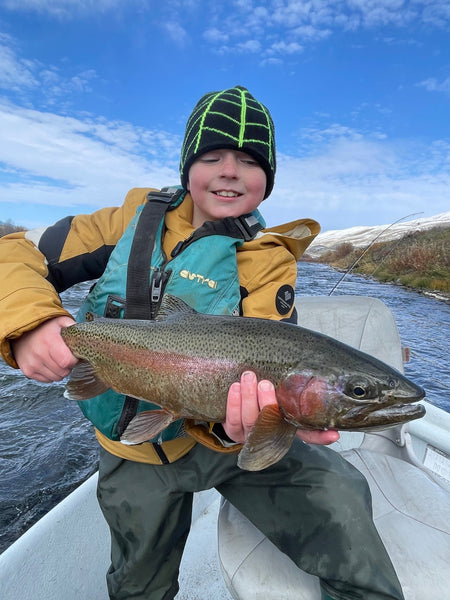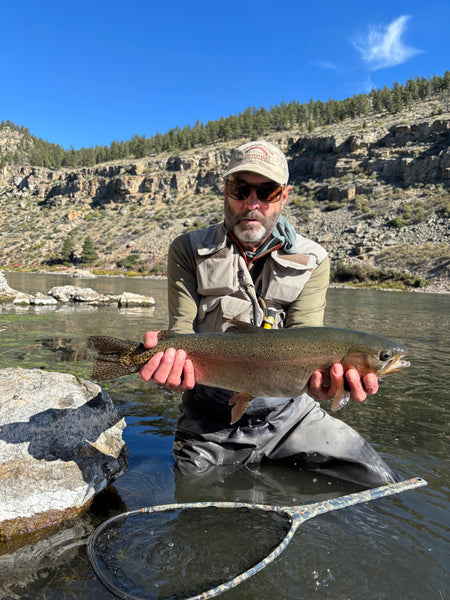Trout Fishing With Wet Flies - Part 2
January 29, 2019
Part 2 of 3 Back to: Part 1 Part 3
Trout Fishing With Wet Flies

In our last post we looked at why and when to fish Wet flies around West Yellowstone. Now we will focus on the flies and how we rig up to fish them.
The flies I swing are normally a size or two bigger than the nymphs or dry flies that I would be fishing at the same time. For instance, throughout the summer I do most of my fishing with a #12 soft hackle as my bottom fly and a #14-16 Diving Caddis pattern as my top fly in the rig. During these same time periods, I am often fishing nymphs in #16-#20 in the same waters. All of my wets and soft hackles are tied on heavy wire hooks, which help to keep them from skating on the surface and minimizes the chances of hooks straightening on the take of a large fish. When picking patterns I like to fish two different styles of flies, often one closely matching the color of the most prominent insects at the time. The second fly is normally either a brighter flashier attractor or something dark and visible.
In most of my wet fly fishing I’m keeping the fly within a foot of the surface, regardless of if I am on the Firehole in June, the Madison below Quake Lake in July or the Madison in the Park the last week in October. A floating line is all that I need.
To my floating line I most often add a nine-foot leader. If I am fishing two flies I prefer to rig the top fly on a dropper. To do this I add additional tippet to my leader with a triple surgeon’s knot and tie my top fly off the tag end of that knot. Make sure to space the two flies out far enough that a fish won’t get snagged on the bottom fly if it slashes at the upper offering and doesn’t get hooked. Two feet of separation is plenty. I keep the tippet size the same for both flies and keep the dropper between 2-4 inches to minimize tangles.
For most of our fishing I fish two flies with the larger fly on the bottom of the rig. For our lake run fish in the fall on the Madison inside Yellowstone I fish a single fly most of the time. This is habit left over from when I was learning to spey cast and didn’t want additional stuff tangling up on my leader. Traditionally teams of wet flies have been fished, with up to five flies on the leader. However in both Yellowstone and Montana it is illegal to fish more than two flies at once.
When fishing soft hackles it is important to not fish too light of tippet. Each fall we have customers come into the fly shop complaining about losing fish on soft hackles. The common theme is that the big lake run fish are breaking their 5X and 6X tippet on the take. Because the fish never see the tippet, you can get away with much heavier tippet than you can fishing a dry fly. Even on the Firehole River where the majority of the fish are under twelve inches I seldom fish wets on lighter than 4x. When larger trout are present I rig with 2X or 3X tippet.
One additional note on rigging is that I tie the flies on with either a Non Slip Loop, a Turle knot, or for small flies a double Davy Knot. Tying the flies with a standard Clinch knot or fisherman’s knot often makes the flies ride on their side which can cause them to plane up in the water column and skate on the surface. This is not desirable.
When fishing soft hackles on a light spey or switch rod, I prefer to fish a tapered mono leader with a Scandi style shooting head. This set up allows for very quiet casting and is effortless to deliver small flies. My leaders are normally a bit longer than the rods I am fishing, in the 13-15 foot range and tapered down to 2X-3X.
If you are more comfortable fishing a poly leader or versi leader on your Scandi line, by all means do. Simply loop on 4-6 feet of level tippet to the front of the poly leader and the rig is good to go. Poly leaders designed for larger spey rods can over load a trout spey set up by adding a lot of grains to the front of the line. Trout poly leaders may give better balance but keep in mind their break strength is not very high. Rio’s new Light Scandi VersiLeaders are an attempt to solve this problem and weight less than half of their Spey Versileaders providing better balance with our 3-5 weight Spey and Switch rods.
When fishing Skagit style lines with soft hackles I favor intermediate tapered sink tips coupled with a 9 to 10 foot tapered leader. The longer leader coupled with a tapered tip allows for a more forgiving anchor that is less likely to blow or come out of the water during my sustained anchor casts. This setup is also a bit more delicate than running an Intermediate T tip with a short bit of tippet.
This concludes our discussion about rigging. In our next post we will get to the good stuff about how to most effectively fish with wets.

Samples of some of Mike's favorite wet flies.
Back to: Part 1
Be sure to check back next week for article 3 of this 3 part series.

About Mike Loebl - Professional Fly Fishing Guide at Madison River Outfitters, West Yellowstone, MT

Mike began fly fishing at the age of 7 in his home state of Michigan, where he would later start his career in the industry at a fly shop in Northville. Fast forward to the present and Mike has been with MRO for the better part of the past two decades. Not only is Mike a certified FFF casting instructor, but he is also well versed in both spey casting and Czech nymphing. As a guide, Mike loves to teach people new techniques and help improve upon what they already know. When not fishing, Mike can be found spending time with his wife Alice Owsley (also a fly fishing guide in the area) and their dog Norman.
3 Responses
John Schilling
Hi Tom – Thanks for following the MRO Blog. We’re happy that you find Mike’s articles useful. Here’s a link to a video on how to tie the Davy knot.
https://www.youtube.com/watch?time_continue=17&v=p0e1DmJRXv0&feature=emb_logo
Tom Me
You talk about using a double Davy Knot, can you share that knot . How its tied. I half all three parts of your wet flies and soft hackle post, I have learned a bunch plan to try it out, when next on the water. Keep up the great posts
Tom O.
Mike,
Very useful info. Thanks
Leave a comment
Comments will be approved before showing up.
Also in Madison River Fishing Report - Upper Madison River Fishing Report - Greater Yellowstone Area Fishing Reports

Madison River Outfitters Fishing Report for 10/21/2025
This is the Last Report of the Year! Have a Great Winter, and We'll See You All This Spring!!





Mike Loebl
Author